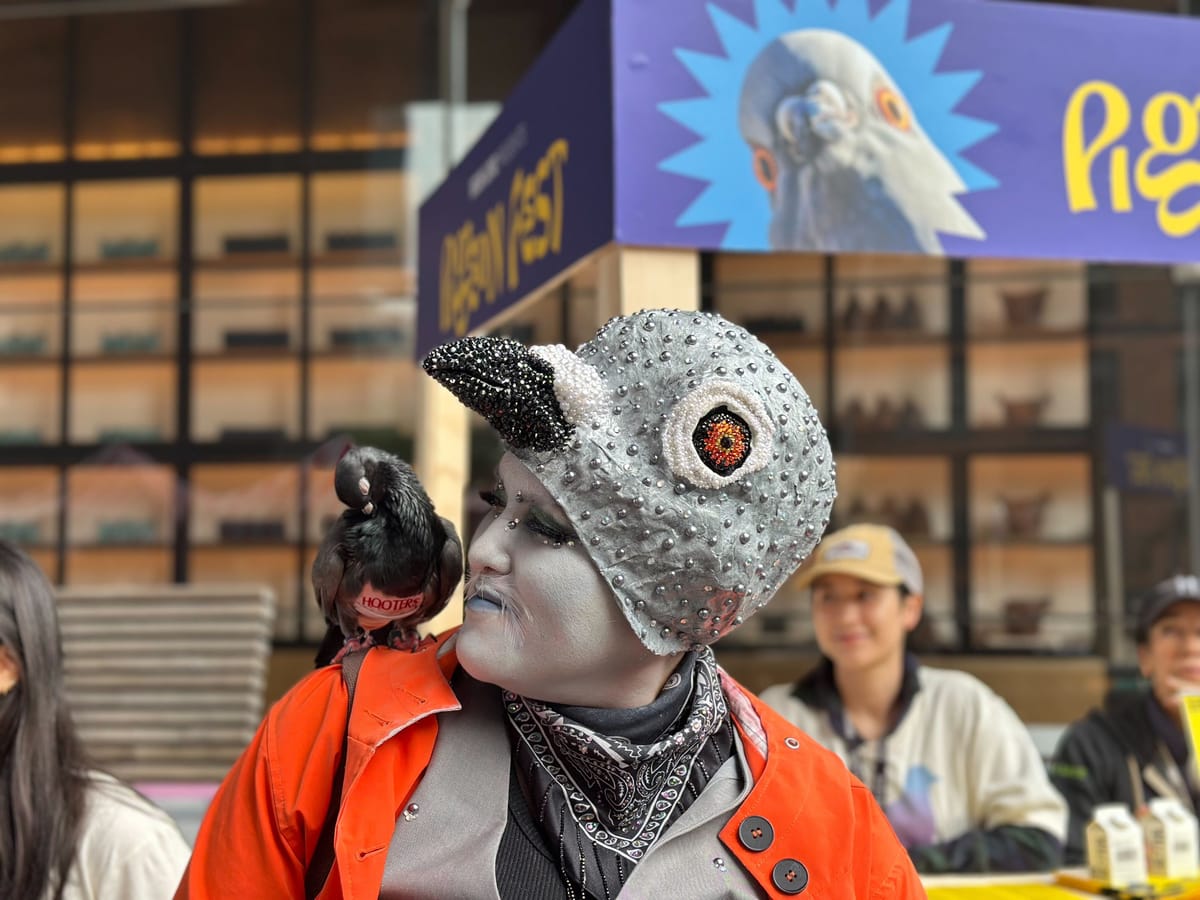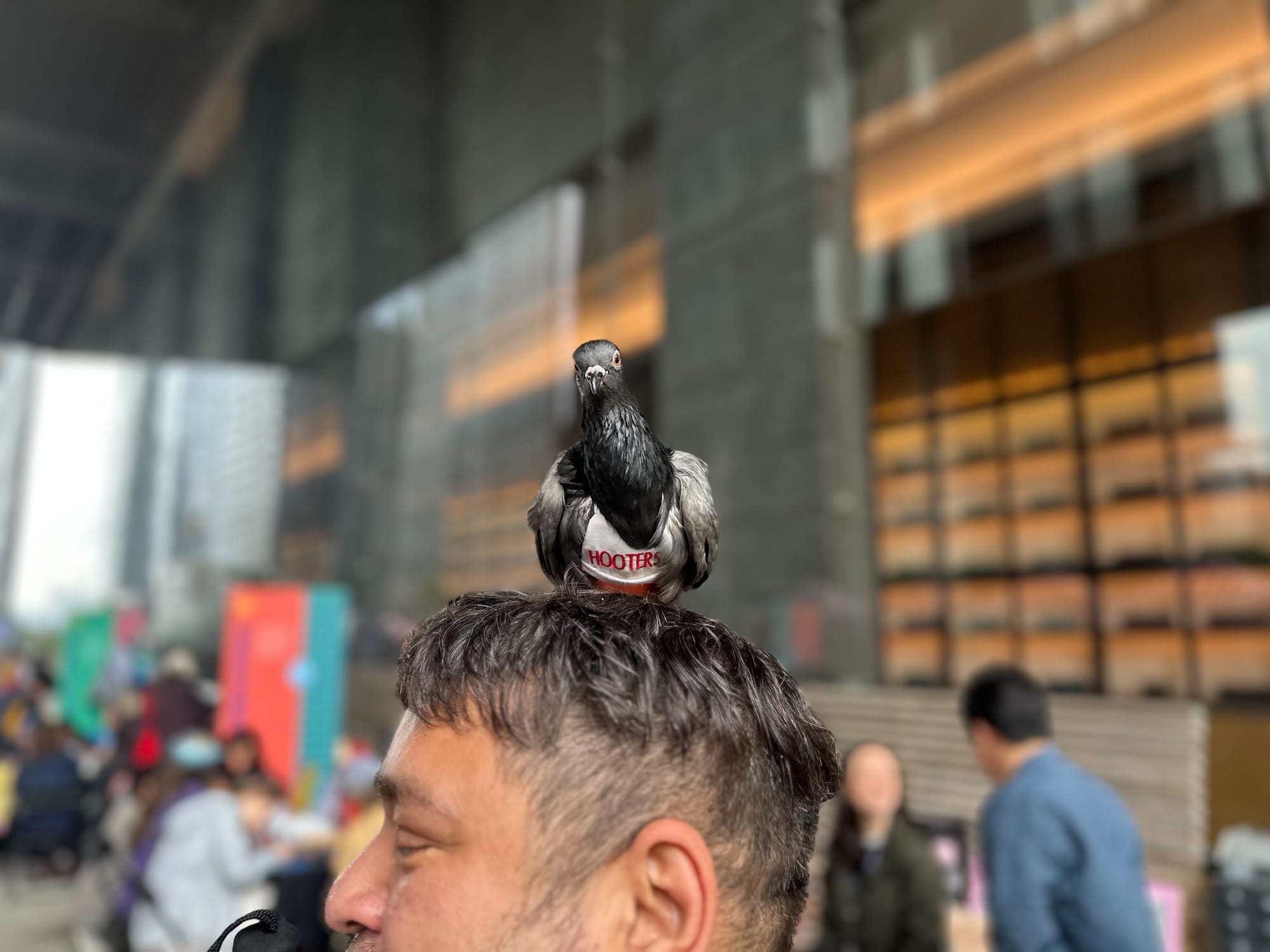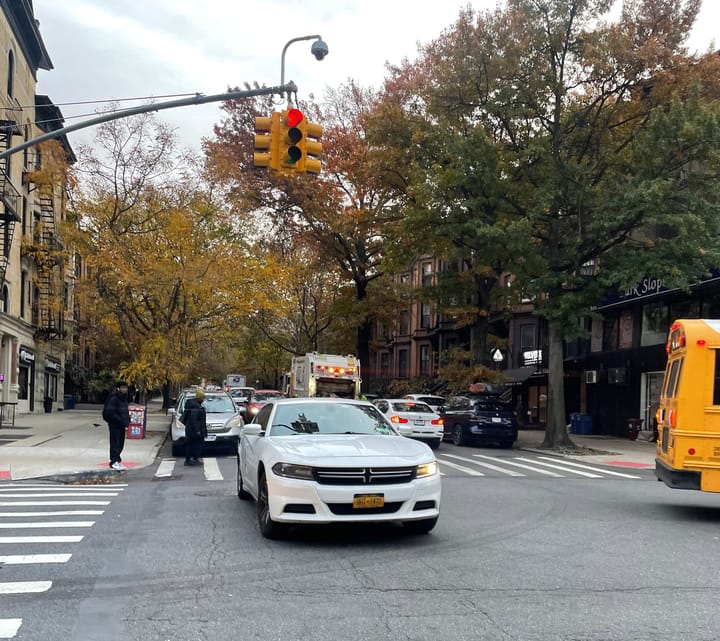Pigeons are so popular right now, people are turning to forgery
In these hard times, a newfound affinity for the common downtrodden pigeon

Pigeons have been everywhere lately, and not just outside. They’ve been all over the news, with coverage about string feet and pigeon thievery, all over the algorithm (Tik Toks, reels, and IG nail pages), and getting a starring act on the High Line with Iván Argote’s Dinosaur, a towering, hyperrealistic pigeon that was installed late last year. Last weekend, the High Line hosted Pigeon Fest, which probably also saturated your feed.
As an avowed pigeonhead, I’m cooing with excitement. I drew them in my notebooks as a kid, give walking tours about them now, and, of course, write in their defense (not! rats! with! wings!). I got into them because, as Rosemary Mosco, who wrote The Pocket Guide to Pigeon Watching, explained in a two part Ologies podcast about pigeons: “When you’re kind of a naturey kid, but you’re in the city, you can't help but notice the pigeons.” But I was curious about what led to their recent rise in pigeon popularity and why others were suddenly into them too, so I looked into it — at Pigeon Fest and beyond.
One couple told me they faked passes using ChatGPT, and another man used an old Evenbrite screenshot to get in.
Pigeon Fest is the first official NYC celebration of the rock dove. Organized by the High Line, the full day festival celebrated “pigeons, urban ecology, and public art” with a pigeon impersonation contest getting the most hype. It featured jazz birdsong, authors of pigeon books, licensed bird vendors and even a pigeon puppet show. Despite the rain, people came all out to celebrate the pigeon (even from as far away as Boston).
The event was so popular that it was at capacity within one hour of opening, with guards having to turn away those who didn’t RSVP for the free event (including multiple crying children, all donning feathers). I watched people who were turned away scheme up other ways of getting in. Some waited on the sidelines asking people who were exiting for their tickets. Later, inside, I talked to two groups of people who seemed to have snuck in — I had watched them be turned away earlier. One couple told me they faked passes using ChatGPT, and another man used an old Evenbrite screenshot to get in. He’d moved to New York last week and this was the first event he’s attended.
“I’m not a particular pigeon fan, but this felt very New York, so I had to make it,” he said.
One guy without a ticket walked up to the guards, said “This is my ticket” and pointed at the pigeon sitting on his head. They let him in. Obviously I had to immediately befriend him, and so I met Damien and Lady Elanor, his emotional-support pigeon. They both came from New Jersey just for Pigeon Fest. Damien adopted Lady Elanor when she fell out of her nest during the pandemic. She sits on his shoulder on a leash in a Hooters onesie.
“The waitresses love her,” Damien said.
Everyone at Pigeon Fest did too. Crowds stopped to hold her, and Damien was stuck within 10 steps of the entry booth for about an hour as people took photos with her. She flew from Damien’s shoulder onto his hand which was raised high, danced to her favorite Michael Jackson songs, flew a few twirls, and then landed on people’s heads.

I asked a few people who stopped to meet Lady Elanor what brought them to Pigeon Fest, and what it was about pigeons that did it for them. The answers varied but most everyone had the same theme: their resilience is a comfort. In these hard times, where everyone feels bad all the time it’s unsurprising we’d have an affinity for the common downtrodden pigeon.
A woman with a pigeon hat she cross stitched herself said, “My favorite thing is how adaptable they are. They can lay an egg on a sidewalk, or an awning.”
Pigeon nests, if you haven’t heard, are absurd but surprisingly hardy. (This is because pigeons are technically rock doves, who nest on flat surfaces, rarely trees). Check out the /stupiddovenests subreddit.
Another woman with a feathered cape got into pigeons because of a sport called pigeon mumbling.
“I used to work in a shop that had been converted from a pigeon mumbling store, so I learned about this culture,” she said. “On Friday night at 7 p.m., these owners let all let the pigeons go, and when they land on someone else’s rooftop, you capture them. You either keep that one and add it to your flock, or you sell it back to the owner for like two dollars. It’s like a live-action Pokemon. These pigeons, they’re just super smart.”
Fun fact, though there are some theories, one of the enduring mysteries about pigeons is that we still don’t fully know how they find their way home. In a time when most everything is searchable, I like that they keep a little mystery for themselves.
They later became unfairly associated with dirt and disease, going from prized to despised.
And of course, there’s the looks. Pigeon fits were represented by all at Pigeon Fest, not just those in the official impersonation contest. Artist AJ Tedstone showed up in her favorite pigeon sweater, tote bag, earrings, necklace, leggings and rings — all the way from Boston. She has a pet pigeon herself named Monty and her favorite thing about pigeons are their beautiful color and cute faces.
“I feel like no one sees how beautiful they are, but if you look closely, each is stunning,” Tedstone said.
The pigeon’s unexpected charm has been increasingly ruffling feathers in fashion. Jeff Staple’s 2005 Nike x Staple Pigeon Dunk collab, helped kicked off sneaker culture with a riot outside the store. Staple turned the pigeon into a streetwear icon, putting them on Timberland boots and North Face puffers (resales of the original shoe go for up to $40,000.). Released in 2023, Jonathan Anderson’s pigeon purse landed on Carrie Bradshaw’s arm in And Just Like That, feeling way more Carrie than SATC’s season 2’s swan bag from Mr. Big. And on TikTok, Alison Jardin regularly goes viral for Pidge, her potty trained pet pigeon. Call it a Birdken.
At Pigeon Fest, they were everywhere too — hats and headbands and tattoos.
Pigeons were actually bred by Victorians for their beauty. Charles Darwin unlocked clues to evolution by noticing how easily we could selectively breed pigeons, calling them “a fountain of variation.” If you take more than a passing glance at a flock of pigeons, this variation starts to emerge: unusual colors, feather patterns, iridescence. This is because pigeons are feral, not wild, descendants of abandoned pets. Some have fancy breeds mixed in leading to unusual characteristics.
On the way home from Pigeon Fest I saw a feather-footed one outside of Penn Station. Notice its feet, not pink like the ones you usually see, but covered in feathers almost down to the toes.
It may have some English Trumpeter in him. (Check out a gallery of breeds by the American Pigeon Museum here.)
Though now considered common, they really were once valued for their beauty, their smarts, and the companionship they gave to people.
So, what happened? Pigeons fell from grace. Once bred for beauty and brains, they got too popular for their own good. As the working class started taking up pigeon keeping, pigeons also became less useful, with modern technology replacing their utility. They later became unfairly associated with dirt and disease, going from prized to despised.
Ecologist Robert Dunn named an ecological phenomenon after them: the Pigeon Paradox. It refers to how people are more likely to care about conservation when they’ve had meaningful contact with nature. But in cities, that contact mostly happens through everyday urban wildlife, like pigeons.
Times are ripe for appreciating them: It’s rough out here for the common man and the common bird.
The problem is, we’ve been incorrectly taught to ignore or dislike the animals we see most often, until now. People are forging passes for pigeon festivals, tattooing pigeons on their arms, sewing pigeon hats and flying in from Boston to show off pigeon-themed outfits. They're flocking (sorry) to celebrate the bird they were once told not to touch.
Why? As people have become reacquainted with the pigeon’s forgotten history, they’ve started to appreciate them again. They’re familiar without demanding attention, smart, but self sufficient. Adaptable, unpretentious, and always fun to watch. Times are ripe for appreciating them: It’s rough out here for the common man and the common bird.
As Iván Argote, the artist behind the High Line’s monumental pigeon sculpture, put it: “What fascinates me about pigeons is that, despite being ever-present, they’re marginalized. They’re our constant companions in the city, yet we tend to despise them.”
In these terrible times, may I offer you a pigeon?




Comments ()